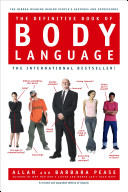Hand-in-Hand Behind the Back Body Posture
Several prominent male members of the British Royal Family are noted for their habit of walking with their head up, chin out and one palm gripping the other hand behind the back. Not only does British Royalty use this gesture; it is common among Royalty of many countries. On the local scene, the gesture is used by the policeman patrolling his beat, the headmaster of the local school when he is walking through the school yard, senior military personnel and others in a position of authority.
This is therefore a superiority/confidence gesture position. It also allows the person to expose his vulnerable stomach, heart and throat regions to others in an unconscious act of fearlessness. Our own experience shows that, if you take this position when you are in a high stress situation, such as being inter- viewed by newspaper reporters or simply waiting outside a dentist’s surgery, you will feel quite relaxed, confident and even authoritative.
Our observation of Australian police officers has shown that the officers who do not wear firearms use this gesture frequently and often rock back and forth on the balls of the feet. However, the police officers who do wear firearms seldom display this gesture, using the hands-on-hips aggressive gesture instead (Figure 98). It seems that the firearm itself has sufficient authority for its wearer so that the palm-in-palm gesture becomes unnecessary as a display of authority.
Notes:
One of my favorites, indicates a relaxed, confident, and authoritative state.
Folksonomies: body language
Taxonomies:
/education/school (0.501648)
/sports/hunting and shooting (0.499682)
/sports/walking (0.470956)
Keywords:
superiority/confidence gesture position (0.955748 (positive:0.579321)), hands-on-hips aggressive gesture (0.888973 (negative:-0.266062)), palm-in-palm gesture (0.634671 (negative:-0.771692)), prominent male members (0.610789 (neutral:0.000000)), British Royal Family (0.592001 (neutral:0.000000)), senior military personnel (0.538078 (neutral:0.000000)), high stress situation (0.515747 (negative:-0.374307)), police officers (0.507461 (neutral:0.000000)), Australian police officers (0.485558 (neutral:0.000000)), authoritative state (0.375822 (positive:0.440310)), Body Posture (0.354081 (positive:0.804019)), sufficient authority (0.332285 (negative:-0.771692)), British Royalty (0.325485 (positive:0.275620)), vulnerable stomach (0.324219 (neutral:0.000000)), unconscious act (0.306544 (positive:0.207838)), throat regions (0.296380 (positive:0.207838)), school yard (0.290673 (neutral:0.000000)), local scene (0.289288 (neutral:0.000000)), local school (0.279742 (neutral:0.000000)), newspaper reporters (0.279210 (negative:-0.242845))
Entities:
British Royal Family:Facility (0.914593 (neutral:0.000000)), one palm:Quantity (0.914593 (neutral:0.000000))
Concepts:
Police (0.966426): dbpedia | freebase | opencyc
British Royal Family (0.966217): website | dbpedia | freebase | yago
Royal Highness (0.601238): dbpedia | freebase | yago
Police officer (0.598021): dbpedia | freebase
Firearm (0.597558): dbpedia | freebase
Genealogy of the British Royal Family (0.569548): dbpedia
High school (0.563009): dbpedia | freebase | opencyc
Commonwealth realm (0.560002): dbpedia | freebase | yago





